Read Time: 7 Minutes Subscribe & Share
Pepper’s Best Friend
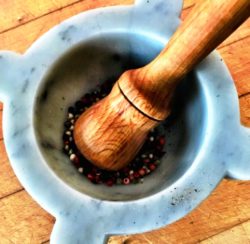 Some time ago, I wrote a post on the different types of peppercorns, which some readers found quite helpful. A few asked for some information on salts, and since I am married to someone who feels that salt is an unalienable right – and we carried a selection in the shop – this post should give you a better understanding about this Ur seasoning. Salt enhances flavors, but it can also subdue bitter flavors and make a delicious counterpoint to sweet ones. It is used in bread baking to strengthen the gluten network, as well as giving a pleasing flavor to the final product. It is more than just sodium chloride.
Some time ago, I wrote a post on the different types of peppercorns, which some readers found quite helpful. A few asked for some information on salts, and since I am married to someone who feels that salt is an unalienable right – and we carried a selection in the shop – this post should give you a better understanding about this Ur seasoning. Salt enhances flavors, but it can also subdue bitter flavors and make a delicious counterpoint to sweet ones. It is used in bread baking to strengthen the gluten network, as well as giving a pleasing flavor to the final product. It is more than just sodium chloride.
A Little History
Salt is probably the oldest seasoning agent in our food history. It is also a preserving agent and has been used medicinally – relieving congestion, aiding in digestion and as a soaking agent to relive pain and stress. Our earliest records of salt production come from China around 3600BC. Our words – salad and salary – are derived from a classic Latin word for salt. A Roman soldier’s salary was in part a portion of salt. A monopoly on the salt trade was one of the reasons that the Venetian Republic developed into a powerful player in Europe.
 Salt is produced either by evaporating salt water or it is mined from old sea beds underground. And in fact, Salzburg in Austria has very polished tours of its salt mines, if you want to know something more about this city other than its being the home of Red Bull and Mozart.
Salt is produced either by evaporating salt water or it is mined from old sea beds underground. And in fact, Salzburg in Austria has very polished tours of its salt mines, if you want to know something more about this city other than its being the home of Red Bull and Mozart.
In the New World, Indian tribes boiled down water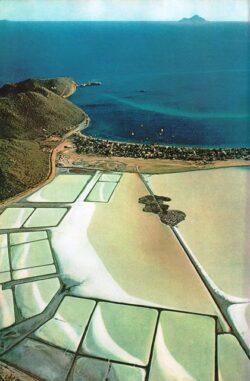 from salt springs. In fact, in the early part of the 17th century, when Dutch explorers first met and later brutally exploited Indian tribes in what is now St Maarten, these tribes were producing salt from a salt reserve. There was such an ugly competition among Spain, the Netherlands and France over the salt beds of St Maarten that it was “divided” among these two latter countries in 1648, a division that remains today. And the ponds are still in operation.
from salt springs. In fact, in the early part of the 17th century, when Dutch explorers first met and later brutally exploited Indian tribes in what is now St Maarten, these tribes were producing salt from a salt reserve. There was such an ugly competition among Spain, the Netherlands and France over the salt beds of St Maarten that it was “divided” among these two latter countries in 1648, a division that remains today. And the ponds are still in operation.
Mined Salt
Most of the salt we use in the US is mined. The two most powerful players are Morton Salt Company, a subsidiary of Stone Canyon Industries, which is the largest salt producer in the world, and Diamond Kosher Salt, which is owned by Cargill, a monolith in our food supply chain with a terrible reputation, and controls many of your grocery purchases. Kosher salt (some say it should be called koshering salt) derives its name from the fact that this particular salt was used in koshering or preserving meat and is not blessed by a rabbi. Its grain is larger and more irregular than table salt and thus less is used to draw out blood from meat and it is easily washed off after that process is finished. Scientists have measured that a spoon of kosher salt has less salt than the same spoonful of fine table salt. I found the most interesting comparison between Diamond and Morton’s version of Kosher salts in a blog: Handle The Heat.
Morton Kosher Salt -This salt is much denser and almost twice as salty by volume as Diamond Crystal! It’s made by rolling cubic crystals of vacuum-evaporated salt into thin, dense flakes. Because it takes longer to dissolve and is almost twice as salty, I avoid using this product because it’s all too easy to accidentally over season your food. Or, to under-season because the salt crystals don’t adhere to your food!
The author of this blog, Tessa Arias, gives a ratio she got from Cook’s Illustrated that if a recipe is written with Diamond Kosher Salt, and you are using the Morton version, you should decrease the volume by 25% and increase it by 50% if the recipe indicates Morton’s kosher salt and you are using Diamond.
Even though both mined salts go through a brine process, she prefers the method used by Diamond and that their Kosher Salt is her go-to salt for cooking. It is made by crystallizing an open container of brine to produce light, hollow flakes. Those flakes adhere to food wonderfully. It’s also far less salty than Morton so it’s much less likely that you’ll over-season your food.
The finer grained table salt made popular by the little girl with the umbrella actually has some additional ingredients – an anti-caking agent, which keeps the salt from solidifying in humid weather (no need for raw rice in the shaker) and powdered iodine sifted into it. This interesting addition was a mandate in the 1920s to improve thyroid hormone production in the US population when studies showed a rising incidence of simple goiter – a problem solved when a diet includes sufficient amounts of iodine-rich seafood and dairy.
There is one more mined salt that has captured the attention of every gourmet food catalog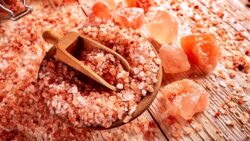 designer – Himalayan Pink Salt. Its color is derived from various forms of algae that have colored the salt over the millennia and it is estimated this rose-colored salt can provide up to 84 different minerals. It comes from mines in Pakistan where an ancient seabed, formed millions of years ago, lay buried. Blocks of it are sold additionally, so that you can grill on it, and it will give a salty taste to the grilled food. There is not enough scientific data to prove that it is a healthier salt than other versions.
designer – Himalayan Pink Salt. Its color is derived from various forms of algae that have colored the salt over the millennia and it is estimated this rose-colored salt can provide up to 84 different minerals. It comes from mines in Pakistan where an ancient seabed, formed millions of years ago, lay buried. Blocks of it are sold additionally, so that you can grill on it, and it will give a salty taste to the grilled food. There is not enough scientific data to prove that it is a healthier salt than other versions.
Evaporated Salt
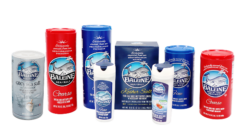 Subjectively speaking, I prefer using a sea salt for cooking than a mined salt. I have occasionally used Diamond Kosher Salt for making Robuchon’s salt crusted beef and similar dishes with fish which are baked in the oven under a mound of salt but have certainly looked for other brands. I use La Baleine both in their fine and coarse crystals for general cooking. I like its taste and price range. Maldon and Fleur de Sel make great finishing salts – and Maldon itself has an interesting production story.
Subjectively speaking, I prefer using a sea salt for cooking than a mined salt. I have occasionally used Diamond Kosher Salt for making Robuchon’s salt crusted beef and similar dishes with fish which are baked in the oven under a mound of salt but have certainly looked for other brands. I use La Baleine both in their fine and coarse crystals for general cooking. I like its taste and price range. Maldon and Fleur de Sel make great finishing salts – and Maldon itself has an interesting production story.
This British company (pronounced without a French accent) has a different approach to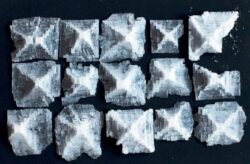 evaporation and it produces a unique, pyramid shaped crystal. As England does not get the heat and wind benefits that Sicily and France do, they use a much different but ingenious technique. Sea water is pumped into salt pans and the resulting brine is carefully brought to the boiling point and then left to reduce for 16 hours. This very carefully regulated process produces the almost mathematically precise crystals you see in this photograph.
evaporation and it produces a unique, pyramid shaped crystal. As England does not get the heat and wind benefits that Sicily and France do, they use a much different but ingenious technique. Sea water is pumped into salt pans and the resulting brine is carefully brought to the boiling point and then left to reduce for 16 hours. This very carefully regulated process produces the almost mathematically precise crystals you see in this photograph.
Solar evaporation is what you see in the salt beds of Trapani, Sicily, the Camargue and the Guerande in France. There are a series of deep and shallower ponds in which the slowly evaporating water is transferred until all that is left is the crystalized residue. In the Guerande, the salt is grayish in color from the choice of clay used to form the ponds. It does have a different taste than the salt created in Trapani or in the Camargue – which makes these salts from different areas so much fun to add to foods.
Fleur de sel, which is a particular specialty of the Guerande salt flats, is now being produced in other salt flats. It is the very top layer of salt crystals that form when the sun and winds combine forces in a certain way. And it takes months for the crystals to dry out and be separated from impurities. This interesting video -admittedly long, but it has English subtitles – explains the subtleties of this most particular of salts.
The best supplier of salts in the US that we dealt with through a distributor was Saltworks in Washington State. You can purchase some of their salts in retail packaging or in bulk amounts, and they produce bath salts as well. Saltworks at one time produced a fleur de sel that was smoked on barrel staves of casks used to produce chardonnay wine. It was the fastest selling aromatized salt we had in the store. I am in mourning that their version is no longer available. I even squirreled away a jar in the 109 boxes that are making their way to Bologna.

Kitchen Detail shares under the radar recipes, explores the art of cooking, the stories behind food, and the tools that bring it all together, while uncovering the social, political, and environmental truths that shape our culinary world.




She can praise the benefits of the Diamond brand over Morton for kosher salt but after reading the Cargill page, that won’t be happening. Not that I’ve ever seen a recipe call for one or the other that I can remember. I’d be interested in looking into getting rid of regular old table salt and switch to the sea salts but I’m guessing most recipes use Morton’s table salt, unless marked kosher or sea salt, so would need to figure out if it’s a 1:1 equivalent.
Hello Jennifer
The preference for Diamond over Morton kosher salt is widespread, I found out. But I am glad you read that page on Cargill. I use sea salt in general as a 1:1 ratio. I have not had to change on baked goods, but more on savory stuff.
Nancy